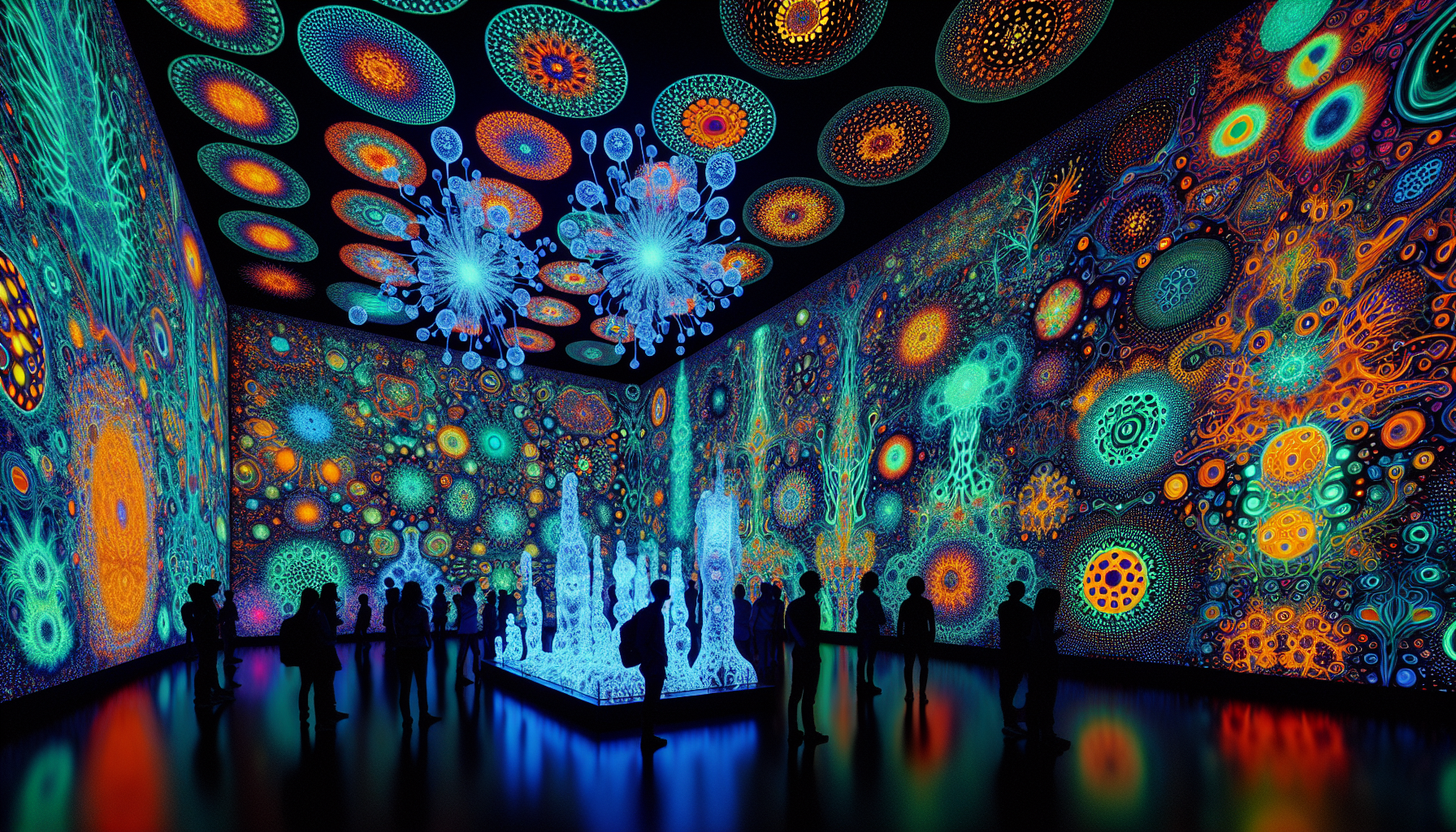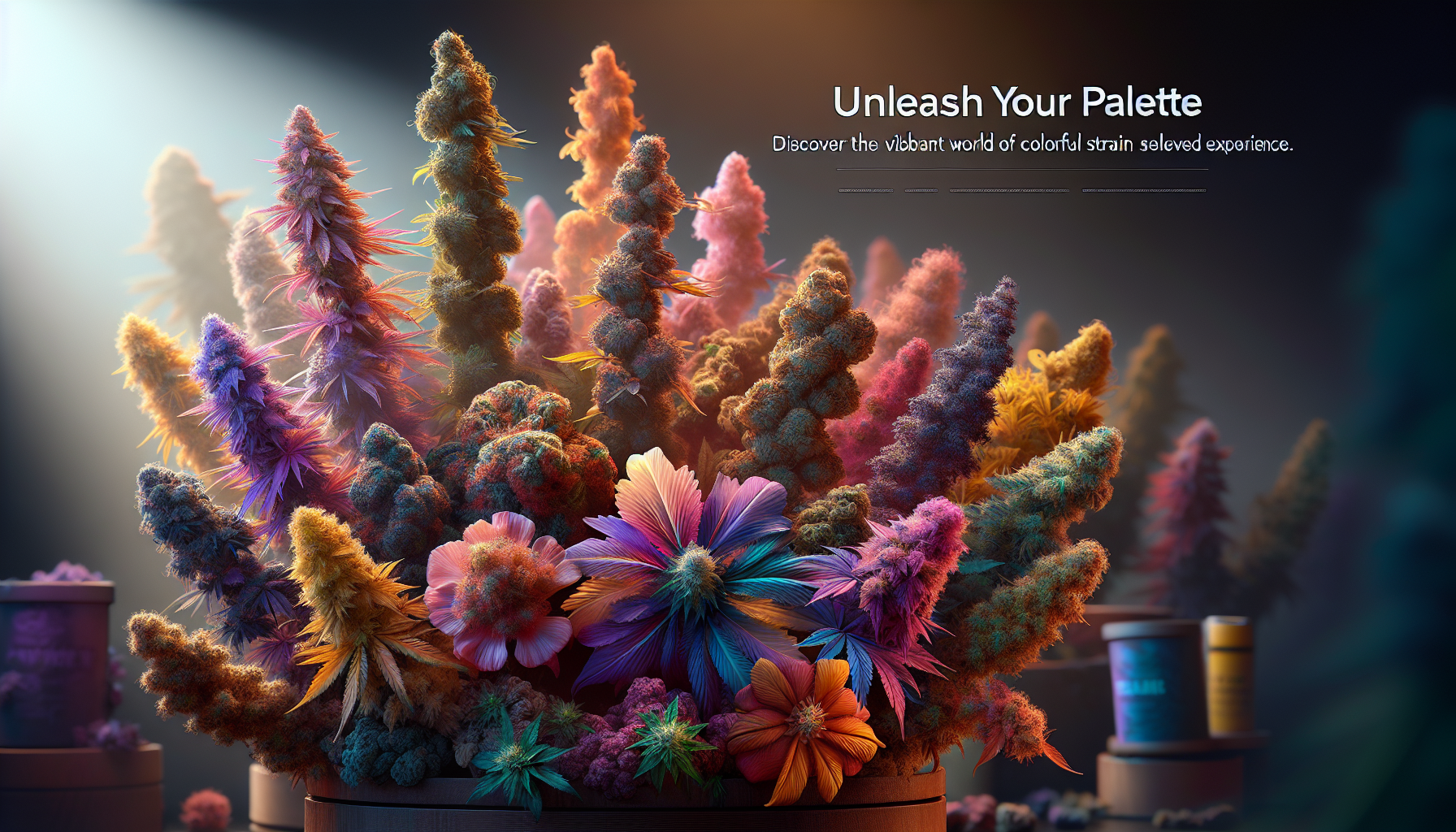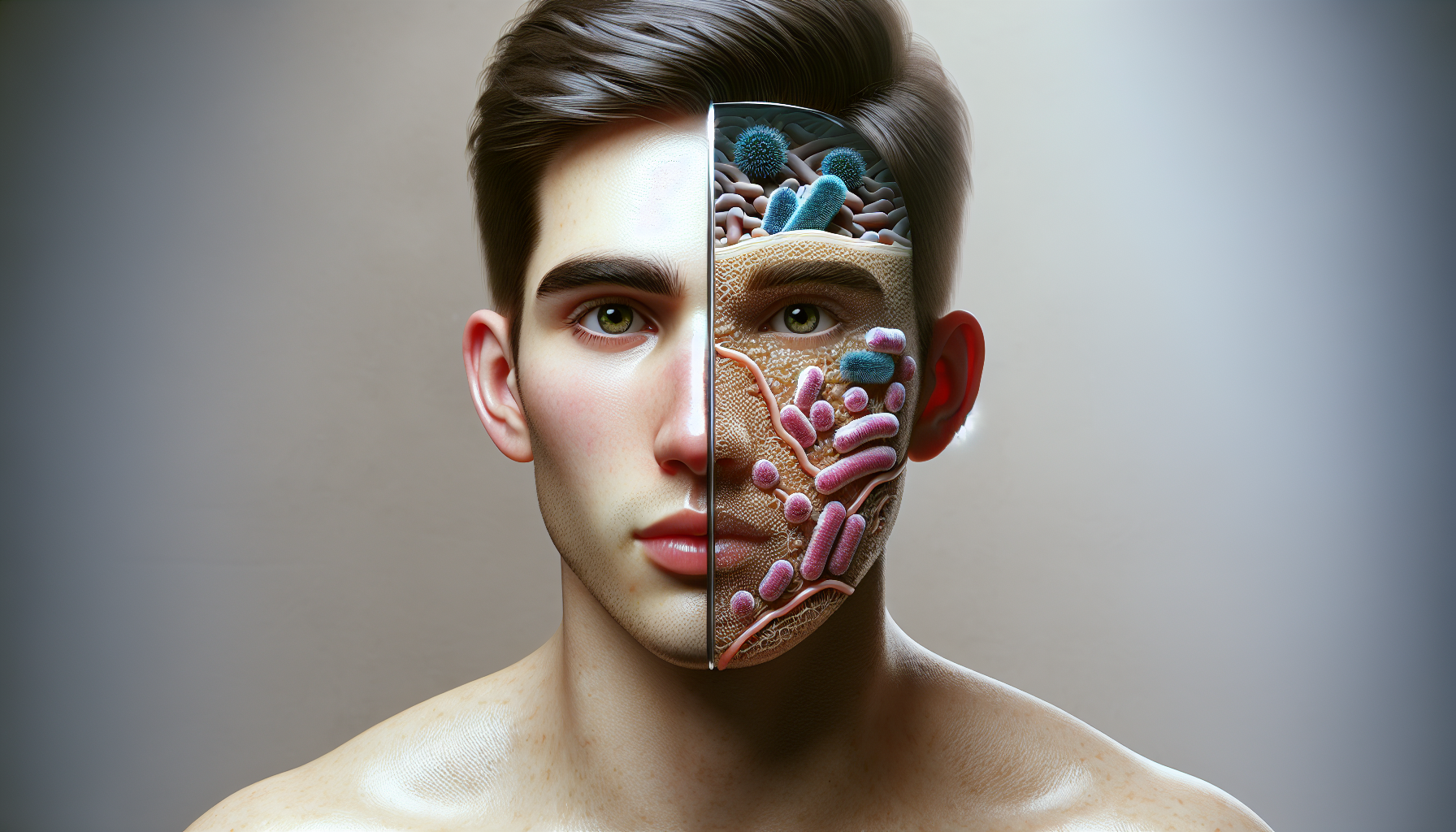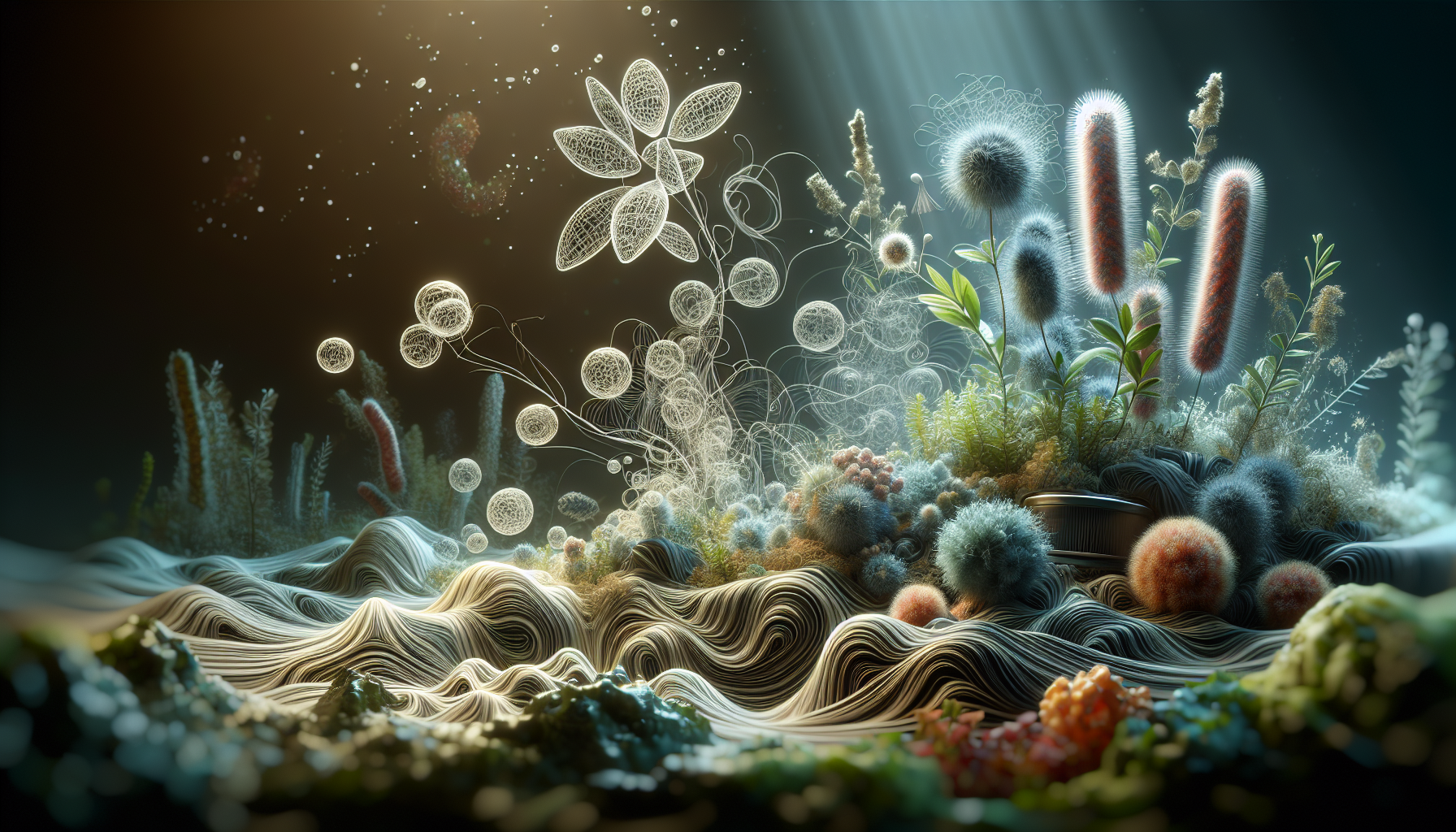In a world where creativity knows no bounds and artistic expression continually evolves, there’s a captivating realm that is drawing enthusiasts and curious minds alike into its luminous embrace: fluorescent strain art. This fascinating art form, which combines the science of bioluminescence with the creativity of visual art, is transforming how we perceive and interact with the spaces around us. Imagine walking into a room where the walls are not just static barriers, but vibrant canvases that glow and change under different lights, creating an atmosphere that is both otherworldly and intimately personal. 🌟 This is the mesmerizing world of fluorescent strain art, a place where biology and artistry intertwine to create living masterpieces.
At the core of fluorescent strain art is a blend of science and imagination. The process involves using genetically modified organisms, often bacteria or yeast, that have been engineered to produce fluorescent proteins. When exposed to ultraviolet (UV) light, these proteins emit a captivating glow, transforming ordinary surfaces into extraordinary displays of color and light. The science behind this phenomenon is rooted in the natural world, where bioluminescent creatures such as jellyfish and fireflies have been enchanting observers for centuries. By harnessing this natural glow, artists can create dynamic works that not only engage the senses but also challenge our understanding of what art can be.
The allure of fluorescent strain art lies in its ability to transform spaces in ways that are both unexpected and immersive. Unlike traditional paintings or sculptures, which remain static, these glowing creations change with the light, offering a different experience from morning to night. As the lighting conditions shift, so too does the artwork, inviting viewers to see the world from new perspectives and encouraging them to engage with their environment in innovative ways. This dynamic quality makes fluorescent strain art not only visually stunning but also deeply interactive, fostering a connection between the observer and the observed that is both intimate and profound.
Beyond its aesthetic appeal, fluorescent strain art offers a unique opportunity for education and engagement. By bridging the gap between art and science, it serves as a powerful tool for teaching complex biological concepts in an accessible and engaging manner. For educators and students alike, these glowing works provide a tangible link to the scientific principles that underpin our world, illustrating the beauty and complexity of life in a way that is both informative and inspiring. Moreover, as our society becomes increasingly interested in sustainable and eco-friendly practices, the potential for fluorescent strain art to promote environmental awareness and conservation efforts is immense, offering a platform for artists and scientists to collaborate in addressing some of the most pressing issues of our time.
In this article, we will delve deeper into the mesmerizing world of fluorescent strain art, exploring its origins, techniques, and the visionary artists who are pushing the boundaries of what is possible. We’ll examine the scientific principles that make this art form possible, as well as the ethical considerations that arise from using living organisms as a medium. Additionally, we’ll showcase some of the most breathtaking examples of fluorescent strain art from around the globe, highlighting the diverse ways in which artists are using this medium to transform spaces and inspire viewers. Whether you are an art enthusiast, a science aficionado, or simply curious about this glowing phenomenon, join us as we illuminate the walls of creativity and explore the captivating fusion of art and science. 🌐
Understanding Fluorescent Strain Art
Fluorescent strain art is a captivating form of artistic expression that combines the beauty of scientific phenomena with creative design. It leverages the unique properties of fluorescent materials to create vibrant, eye-catching pieces that change appearance under different lighting conditions. This art form has gained popularity not only among artists but also among scientists and educators who see its potential in making science more accessible and engaging.
At the heart of fluorescent strain art is the concept of fluorescence, which is the ability of a substance to absorb light at one wavelength and emit it at another, typically longer wavelength. This phenomenon is commonly observed in various biological and chemical substances. By strategically applying these materials onto different surfaces, artists can create intricate patterns that glow brilliantly under ultraviolet (UV) light. This creates a dynamic viewing experience, where the artwork can look completely different depending on the lighting environment.
The beauty of fluorescent strain art lies in its versatility. It can be used to transform mundane objects into mesmerizing works of art. From home decor to fashion accessories, the potential applications are limitless. This art form also opens up a new world of possibilities for interactive installations in museums and galleries, where viewers can be part of the experience by interacting with the art under different lighting conditions.
The Science Behind Fluorescent Materials
To fully appreciate fluorescent strain art, it’s essential to understand the science behind fluorescent materials. These substances are often composed of organic compounds known as fluorophores, which are responsible for their glowing properties. When exposed to light, fluorophores become excited and release energy in the form of visible light. This process is known as photoluminescence, and it is at the core of how fluorescent strain art functions.
There are several types of fluorescent materials used in art, each with its unique characteristics. For instance, some materials emit light in vibrant colors like neon green, blue, or red, while others might glow with softer hues. This variety allows artists to choose specific materials that best suit their vision and desired aesthetic. Furthermore, advances in technology have led to the development of more stable and long-lasting fluorescent pigments, ensuring that artworks maintain their brilliance over time.
One of the most exciting aspects of fluorescent strain art is its ability to incorporate different scientific principles. For instance, some artists experiment with bioluminescent materials, which are derived from natural sources such as jellyfish and fireflies. These materials offer a sustainable and eco-friendly alternative to synthetic fluorophores, adding another layer of depth to the artwork. By blending art with science, fluorescent strain art not only captivates the senses but also educates and inspires curiosity about the natural world.
Creating Your Own Fluorescent Strain Art
If you’re intrigued by the possibilities of fluorescent strain art, you might be wondering how you can create your own masterpiece. The good news is that with the right materials and techniques, anyone can explore this art form. The first step is to gather the necessary supplies, which typically include fluorescent paints or pigments, UV lights, and a suitable surface to apply the art. You can find many tutorials and guides online to help you get started.
When creating fluorescent strain art, it’s important to consider the interaction between light and the materials used. Experimenting with different light sources can yield fascinating results, as the appearance of the art can change dramatically under various lighting conditions. Additionally, incorporating other artistic techniques, such as layering and texture, can add depth and complexity to your work.
To help you get started, here’s a video tutorial that covers the basics of creating fluorescent strain art. Watch and learn as experienced artists share their tips and tricks for bringing your creations to life.
How to Create Fluorescent Strain Art – Creative Art Channel
Applications and Impact of Fluorescent Strain Art
Fluorescent strain art has far-reaching applications beyond traditional art settings. In the world of interior design, it can transform spaces by adding a touch of whimsy and color that changes with the time of day. Imagine walking into a room during the day and seeing a beautiful mural, then returning at night to witness it glow with a completely different ambiance. This transformative quality makes fluorescent strain art an appealing choice for homeowners and businesses looking to create unique and memorable environments.
Beyond its aesthetic appeal, fluorescent strain art also holds educational value. Science museums and educational institutions are increasingly using this art form to engage visitors and teach scientific concepts in an interactive manner. By showcasing the principles of fluorescence and photoluminescence through art, educators can inspire curiosity and a deeper understanding of science among students and the general public.
Moreover, the use of eco-friendly fluorescent materials can promote sustainability in art practices. By choosing natural and renewable sources for pigments, artists contribute to a more sustainable future while still creating stunning works of art. This aligns with the growing movement towards environmentally conscious art, where creators seek to minimize their ecological footprint.
Comparative Analysis: Traditional Art vs. Fluorescent Strain Art
| Aspect | Traditional Art | Fluorescent Strain Art |
|---|---|---|
| Medium | Paints, canvas, sculpture materials | Fluorescent paints, UV-reactive materials |
| Visual Impact | Static under different lighting conditions | Dynamic and changes with lighting |
| Interactivity | Limited to viewing | Interactive, can engage with UV light |
| Applications | Galleries, homes, public spaces | Galleries, homes, educational settings, interactive exhibits |
As you can see, while traditional art has its timeless appeal, fluorescent strain art offers a new dimension of interactivity and visual dynamism that is hard to achieve with conventional materials. By embracing both art forms, artists and viewers can enjoy a richer and more varied artistic experience.
Conclusion: The Future of Fluorescent Strain Art
Fluorescent strain art represents a fascinating intersection of art and science, offering endless possibilities for creativity and innovation. As more artists and creators explore this medium, we can expect to see even more stunning and thought-provoking works that challenge our perceptions and inspire awe. Whether you’re an artist looking to experiment with new techniques or an art enthusiast eager to experience something different, fluorescent strain art invites you to illuminate your world in ways you’ve never imagined.✨
- Explore the science behind fluorescence
- Create your own fluorescent artworks
- Transform your living space with dynamic art
- Learn about sustainable art practices

Conclusion
As we draw the curtains on our exploration of the mesmerizing world of fluorescent strain art, it’s crucial to reflect on the fascinating journey we’ve embarked upon. Throughout this article, we’ve delved into the intricate and vibrant realm where art meets science, and walls become canvases of luminous wonder. This unique art form not only transforms spaces but also challenges our perception of color and light, blending creativity with a touch of scientific innovation.
We began by understanding the origins of fluorescent strain art, tracing its roots back to the advent of fluorescence in scientific research. The phenomenon of fluorescence has captivated scientists for decades, offering insights into everything from biological processes to material sciences. However, its application in art is relatively novel and revolutionary. Artists have harnessed this property to create works that not only captivate the eye but also provoke thought and emotion. By infusing pigments with fluorescent properties, these artists have managed to transform ordinary walls into extraordinary spectacles of color and light.
One of the key aspects we’ve covered is the methodology behind creating fluorescent strain art. It involves a meticulous process where artists carefully select materials and pigments that react to UV light, resulting in a glow that is both ethereal and captivating. This technique requires a deep understanding of both artistic principles and scientific nuances, making it a true interdisciplinary pursuit. The application of these artworks is versatile, ranging from interior design in homes to grand installations in public spaces, each piece uniquely interacting with its environment.
The impact of fluorescent strain art extends beyond mere aesthetics. It plays a significant role in shaping the ambiance of a space, influencing mood and perception. The vibrant hues and dynamic interplay of light and shadow can evoke a range of emotions, from tranquility to excitement. This transformative power of art has therapeutic implications as well, with studies suggesting that exposure to certain colors can influence mental health and well-being. By integrating such art forms into our living and working spaces, we can create environments that not only look beautiful but also foster a sense of harmony and inspiration.
Moreover, fluorescent strain art serves as a bridge between the realms of art and science. It encourages dialogue and collaboration between artists and scientists, fostering innovation and pushing the boundaries of what is possible. This fusion of disciplines can lead to the development of new materials and techniques, ultimately enriching both fields. As we continue to explore the potential of fluorescence in art, the possibilities seem boundless, promising new discoveries and creations that will continue to captivate and inspire.
In today’s fast-paced world, where digital art often takes center stage, the tactile and immersive experience of fluorescent strain art offers a refreshing counterpoint. It invites viewers to pause, observe, and engage with their surroundings in a meaningful way. By transforming everyday spaces into realms of wonder, this art form encourages us to see the world through a different lens, appreciating the beauty that can be found in the interplay of light and color.
As we conclude, it’s important to recognize the broader implications of embracing such innovative art forms. In doing so, we not only enrich our personal environments but also contribute to the cultural and artistic tapestry of our communities. The presence of such art can inspire future generations, igniting their curiosity and encouraging them to explore the intersection of art and science.
We invite you, dear reader, to take the insights gained from this exploration and consider how you might incorporate the magic of fluorescent strain art into your own life. Whether it’s through supporting artists, experimenting with your own creations, or simply appreciating the works you encounter, your engagement can help sustain and grow this vibrant artistic movement.
In closing, we encourage you to share your thoughts and experiences with fluorescent strain art. Your comments and discussions can spark new ideas and collaborations, further enriching this dynamic field. Share this article with friends and colleagues who might find inspiration in these glowing works of art. Let us together illuminate our walls and lives with the mesmerizing brilliance of fluorescent strain art, fostering a world where creativity and innovation shine brightly. 🌟
For further reading on the intersection of art and science, you can explore Smithsonian Magazine or dive into the latest research at ScienceDirect. These resources provide a wealth of information on both historical and contemporary developments in this fascinating field.
Toni Santos is a visual explorer and microscopic storyteller who delves into the hidden aesthetics of microbial life. Through a fusion of scientific curiosity and artistic insight, Toni transforms the overlooked world of bacteria, fungi, and cellular forms into mesmerizing visual narratives—revealing the elegance, symmetry, and chaos that thrive at microscopic scales.
Rooted in a fascination with life forms too small to see yet too intricate to ignore, Toni’s work captures the bizarre beauty of microbial colonies, biofilms, and spore patterns. These images aren’t just representations—they are celebrations of the artistic intelligence encoded in nature’s tiniest architects.
With a background in visual design and bio-inspiration, Toni merges scientific imaging techniques with creative expression, transforming petri dish cultures, fluorescence microscopy, and microbial textures into works that provoke both wonder and contemplation.
As the creative force behind Vizovex, Toni offers curated visual studies, microbial-inspired designs, and essays that bridge art and microbiology—inviting viewers to reimagine what beauty means at the edge of perception.
His work is a tribute to:
The hidden geometries of living systems
The surprising elegance of microbial growth
The role of micro-life in shaping visual culture
Whether you’re a scientist, artist, or simply curious about the unseen world that sustains us, Toni opens a window into a universe where life writes poetry in colonies and patterns, one microbe, one frame, one breathtaking detail at a time.





